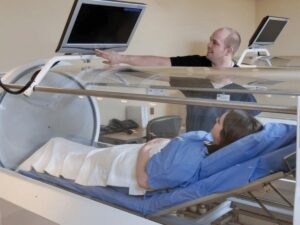We all know that the medical world is always looking for new ways to fight diseases. One method, called Hyperbaric Oxygen Therapy, is starting to get more attention. Many people, including doctors and health companies, are asking: what does Hyperbaric Oxygen Therapy treat?
Hyperbaric Oxygen Therapy is a special treatment that’s helping with many health problems. These can range from long-lasting wounds to a problem called decompression sickness. In this guide, we will learn more about how this treatment works and what it can do.
So, are you ready to discover the amazing power of this therapy? Let’s dive in!
1. Brief Overview of Hyperbaric Oxygen Therapy
Delving into the realm of medical science, there often, come across fascinating therapies. Today, let’s discuss one such therapy, that has not only a rich history but is also being used in contemporary times to aid recovery from various conditions. It offers a unique approach to healing and has been subjected to extensive research to understand its full potential and effectiveness. Let’s unpack this together!
What is Hyperbaric Oxygen Therapy (HBOT)?
Hyperbaric Oxygen Therapy (HBOT) represents a medical treatment that leverages 100% oxygen in a pressurized environment to expedite the healing process. This procedure, usually performed within a chamber, increases oxygen concentration in the body up to twenty times the normal level. The enhanced oxygen availability aids in repairing tissues, reducing inflammation, and combating infections.
HBOT delivers remarkable value to businesses in the healthcare sector. Offering this service can enhance the care portfolio of healthcare providers, with the potential to address diverse health complications that traditional therapies might not reach. Furthermore, the procedure’s demand continues to grow as more studies highlight its effectiveness, thus offering significant growth opportunities for businesses.

Brief History of Hyperbaric Oxygen Therapy
The usage of hyperbaric chambers dates back to the 17th century when British physician Henshaw constructed a system known as a domicilium to treat a range of ailments. However, the modern version of HBOT was truly pioneered in the mid-20th century when it was employed to treat decompression sickness in deep-sea divers.
Fast forward to today, it has grown in scope and has been subjected to scientific scrutiny to ascertain its efficacy in various other clinical applications. A point to note here is that even though hyperbaric oxygen therapy might seem like a recent phenomenon, its roots are deep-seated in our medical history. I find it remarkable how an idea born centuries ago continues to be relevant in the present day. Gwen from Total Shape Magazine has got the same findings.
How Does Hyperbaric Oxygen Therapy Work?
The mechanism behind HBOT is fairly straightforward. Patients breathe in pure oxygen in a pressurized chamber, where the atmospheric pressure is raised up to three times higher than normal. This allows the lungs to gather more oxygen than they would at normal air pressure.
The increased oxygen uptake by the blood leads to a higher oxygen supply to the body’s tissues and organs. This process aids in healing, reduces swelling, and fosters the formation of new blood vessels. In my experience with OxygenArk, one of the leading hyperbaric chamber manufacturers, I’ve observed that patients often report feeling revitalized after their therapy sessions.
2. The Proven Benefits of HBOT
With the evolution of science and technology, it has now been able to shed light on the numerous advantages of HBOT. It’s proven to be a boon in several areas of medicine, contributing significantly to patient recovery and well-being. Here are some details to explore:
| Condition |
Proven Benefit of HBOT |
| Decompression Sickness |
Improves oxygen supply, decreases bubble size, reducing symptoms and aiding recovery. |
| Arterial Gas Embolism |
HBOT reduces the size of the gas bubbles, improving blood flow and reducing symptoms. |
| Carbon Monoxide Poisoning |
Increases the rate at which carbon monoxide is removed from the body and reduces the risk of complications. |
| Delayed Radiation Injury |
Helps to promote new blood vessel growth and reduce inflammation. |
| Skin Grafts and Flaps |
Enhances the survival of grafts or flaps and encourages wound healing. |
| Crush Injuries and Suturing of Severed Limbs |
Reduces swelling and promotes healing. |
| Diabetic Wounds |
Increases the amount of oxygen in the blood, accelerating the healing process. |
| Necrotizing Soft Tissue Infections |
Enhances the body’s ability to fight bacteria and boosts white blood cells. |
| Osteomyelitis (Refractory) |
Augments the effect of antibiotics, stimulates the immune system, and promotes healing. |
| Idiopathic Sudden Sensorineural Hearing Loss |
HBOT has been shown to improve hearing in some cases when used early. |
Improved Healing and Recovery
Hyperbaric oxygen therapy accelerates wound healing by boosting collagen formation and new blood vessel growth. The high concentration of oxygen delivered to the tissues not only supports the healing process but also helps to fight off certain types of infections. In practice, the sight of a patient’s wound healing faster than anticipated is always a heartening one.
Boosted Immune Response
One of the lesser-known benefits of HBOT is its potential to bolster the immune response. By increasing oxygen levels in the body, HBOT promotes the activation and proliferation of white blood cells. One great example is, these cells play a key role in defending the body against infections and disease. Look for hyperbaric chambers that are proven to be effective in this area.
Enhanced Neurological Function
HBOT has also been shown to be beneficial in managing certain neurological conditions. For example, in cases of traumatic brain injury, therapy has helped to reduce symptoms and improve quality of life by promoting neurogenesis and reducing inflammation. I’ve witnessed the positive impact of HBOT on patients dealing with neurological conditions, and it’s genuinely rewarding to see them regain a semblance of normalcy in their lives.
3. Medical Conditions Treated by Hyperbaric Oxygen Therapy
Harnessing the power of oxygen, hyperbaric oxygen therapy (HBOT) brings about medical miracles every day. By creating a pressurized environment, HBOT allows for greater oxygen absorption in the body, leading to accelerated healing and recovery. A variety of medical conditions can benefit from this treatment, each with its own unique set of challenges. Let’s see below some of the significant details to take note of:
Decompression Sickness
Decompression sickness, often a hazard for scuba divers, is one of the main conditions treated by HBOT. This occurs when divers ascend too quickly, leading to the formation of nitrogen bubbles in their bloodstream. The pure oxygen provided in an HBOT session helps to shrink these bubbles and alleviate the symptoms. Trust me, witnessing the relief on a patient’s face post-treatment is priceless.
Gas Embolism
Similar to decompression sickness, gas embolism involves air bubbles in the bloodstream, but this condition can be caused by surgical procedures or trauma as well. In this case, the pressurized oxygen delivered during an HBOT session helps dissolve these bubbles, restoring normal blood flow and preventing further tissue damage. Choose hyperbaric chambers that are renowned for efficiency in such cases.
Carbon Monoxide Poisoning
Carbon monoxide poisoning is a potentially lethal condition where the toxic gas replaces oxygen in the bloodstream. HBOT is often the primary treatment in severe cases, as it can quickly replenish the body’s oxygen supply and expel carbon monoxide, reducing the risk of long-term neurological complications.
Treating Infections
Certain stubborn infections, including those caused by anaerobic bacteria, respond positively to HBOT. The increased oxygen levels in the body’s tissues create a hostile environment for these bacteria, thus assisting in the eradication of the infection.
Chronic Wound Management
Managing chronic wounds, especially in patients with diabetes or radiation injuries, can be a major medical challenge. Thankfully, HBOT can enhance the healing process by improving oxygen supply to these areas, thus promoting tissue repair and regeneration. From my experience, it’s a game changer in wound management.
4. The Treatment Process
The process of hyperbaric oxygen therapy is intricate yet fascinating. This remarkable medical treatment requires careful preparation, procedure, and aftercare. To put it simply, it’s like embarking on a healing journey where the destination is recovery. Seeing patients progress through each phase is truly rewarding for me. Here are the vital key points to keep in mind:
Preparing for an HBOT Session: What To Expect
Before starting a session, medical professionals ensure that the patient is comfortable and aware of what lies ahead. Loose clothing is recommended to ensure comfort within the chamber. The patient will also be guided on ear-popping techniques to manage pressure changes during therapy.
Step-by-Step: The HBOT Procedure
This step-by-step is aimed at demonstrating the intricacies of HBOT as a technique renowned for its curative capacities. Here are the essential elements that must never be forgotten:
Step#1 Patient Assessment and Consultation
The Hyperbaric Oxygen Therapy (HBOT) journey starts with an initial consultation. It involves a comprehensive assessment of the patient’s condition and medical history. The practitioner’s objective is to evaluate whether HBOT is an appropriate solution for the given health condition. A detailed plan is then formulated, outlining the frequency and duration of the HBOT sessions.
Step#2 Preparing the HBOT Chamber
The next phase involves preparing the HBOT chamber. It requires ensuring the chamber is clean and ready for use, and that all operational parameters are correctly set. This includes checking the pressure level, oxygen supply, and any supporting equipment such as monitors or audio-visual entertainment devices. Such preparation guarantees a comfortable and safe session for patients.

Step#3 Patient Introduction to the HBOT Chamber
In this phase, patients are introduced to the HBOT chamber. Careful consideration is taken to familiarize the patients with the chamber’s setup, its working, and safety measures. The healthcare team ensures that patients are comfortable and their questions are answered thoroughly. The main goal is to ensure patients feel safe and secure during the HBOT sessions.

Step#4 The HBOT Session
The HBOT session begins by safely securing the patient inside the chamber. Once inside, the chamber is gradually pressurized, and the oxygen level is increased as per the pre-determined plan. This process, known as compression, takes approximately 10 to 20 minutes. Once the desired pressure is reached, patients start their treatment.

Step#5 Monitoring During the Session
Throughout the HBOT session, patients are constantly monitored. This includes monitoring vital signs, ensuring patient comfort, and checking equipment performance. Timely updates and responsive actions to any changes are crucial to ensuring the effectiveness and safety of the treatment.

Step#6 The Decompression Phase
Toward the end of the HBOT session, the chamber undergoes a decompression phase. The pressure in the chamber is slowly reduced back to normal, allowing the patient to adjust. This phase usually takes about 10 minutes, during which the patient’s vitals are continuously monitored.
Step#7 Post-Session Patient Care
After the session, the patient exits the chamber, and a post-session assessment is performed. This assessment includes checking the patient’s overall response to the therapy, noting any side effects, and recording the treatment details for future reference. I believe the patient’s feedback is also essential for adjusting future treatment sessions if necessary.
Aftercare and Recovery Post-HBOT
After undergoing HBOT, patients typically require some rest to allow their bodies to adjust to the normal atmospheric pressure. The healthcare team will monitor the patient’s vital signs and provide necessary guidance. Subsequent sessions are scheduled based on the patient’s individual treatment plan. In my experience, the dedication of patients to their recovery process is both humbling and inspiring.
5. Safety and Risks of Hyperbaric Oxygen Therapy
As with any therapeutic intervention, it’s crucial to understand the safety considerations and risks associated with Hyperbaric Oxygen Therapy. The safety of the procedure relies on several factors including appropriate patient selection, meticulous monitoring during the therapy, and rigorous maintenance of the equipment involved. Here is some important information to take note of:
Improved Safety Practices
Enhanced safety protocols play an instrumental role in minimizing risks associated with Hyperbaric Oxygen Therapy. These include patient screening for contraindications, like certain lung diseases or uncontrolled fever, and careful monitoring of pressure and oxygen concentration in the chamber. Precise upkeep of the chamber is also vital, along with the need for emergency preparedness to handle any unforeseen circumstances.
Patient Comfort and Anxiety
For some individuals, being in a closed environment can trigger feelings of anxiety or fear being in a closed place. The therapy team takes steps to ensure comfort, such as keeping the patient informed about what to expect during the session and maintaining regular communication. The design of modern chambers with clear walls allows patients to see outside, helping reduce feelings of confinement.
Fire Hazard
A potentially major risk of Hyperbaric Oxygen Therapy is fire. Given the high concentration of oxygen, any ignition source could lead to a fire. It is vital to always exercise and promote strict safety guidelines in place to mitigate this risk, such as prohibiting items like lighters, matches, or any electronic devices within the chamber.
Ear Discomfort
A risk associated with the increased pressure used in the therapy is mild discomfort or pain. This may affect the ears, sinuses, or lungs, and is typically a result of the rapid change in pressure. However, careful and slow pressurization and depressurization of the chamber can help avoid this risk. Patients are also taught techniques to help equalize pressure in their ears and sinuses during the procedure.
6. How to Access Hyperbaric Oxygen Therapy
Navigating the pathway to access Hyperbaric Oxygen Therapy can be eased by understanding the steps involved. This includes knowing when the treatment might be beneficial and etc. Let’s take a look at some of its particulars. See the details below:
When to Consider Hyperbaric Oxygen Therapy
Hyperbaric Oxygen Therapy is a treatment option for a variety of conditions such as serious infections, wounds that may not heal because of diabetes or radiation injury, and bubbles of air in blood vessels. The therapy may also be considered when traditional treatments aren’t providing sufficient results. Consider OxygenArk’s hyperbaric chambers, which are proven safe and FDA-cleared.
Getting a Referral
Accessing Hyperbaric Oxygen Therapy typically starts with a referral from a primary care physician or specialist. Based on the patient’s condition and medical history, a healthcare professional will make an assessment to determine if this therapy would be beneficial.
Understanding the Financial Aspects
The cost of Hyperbaric Oxygen Therapy can vary based on numerous factors, including the condition being treated and the number of sessions required. It’s crucial for a company to check with its insurance provider regarding coverage for this therapy.
Finding the Right Facility
Finally, it’s essential to find a suitable facility that offers Hyperbaric Oxygen Therapy. This could be a hospital or a specialized treatment center. From my point of view, the chosen facility should have proper accreditation and a well-trained team to ensure the best possible care.
Dive Deeper Into Our Resources
Looking for more diverse product options? Browse through our handpicked selections:
For some insightful reads, we’ve curated a list of recommended articles just for you:
Still haven’t found what you’re looking for? Don’t hesitate to contact us. We’re available around the clock to assist you.
7. Conclusion
To summarize, a detailed exploration of Hyperbaric Oxygen Therapy (HBOT) has been accomplished. Its numerous applications were discussed, from assisting in wound healing to potential neurological benefits. The therapy, its benefits, and its uses are fascinating and seemingly infinite.
Could this cutting-edge therapy be the solution to ongoing medical challenges in the line of your business? The answer might be closer than one thinks. OxygenArk, an esteemed manufacturer of hyperbaric chambers, invites inquiries and encourages dialogue for potential benefits and applications of HBOT. Feel free to reach out with any questions or thoughts. Reach out to us for answers, guidance, and partnerships. Contact us now!





